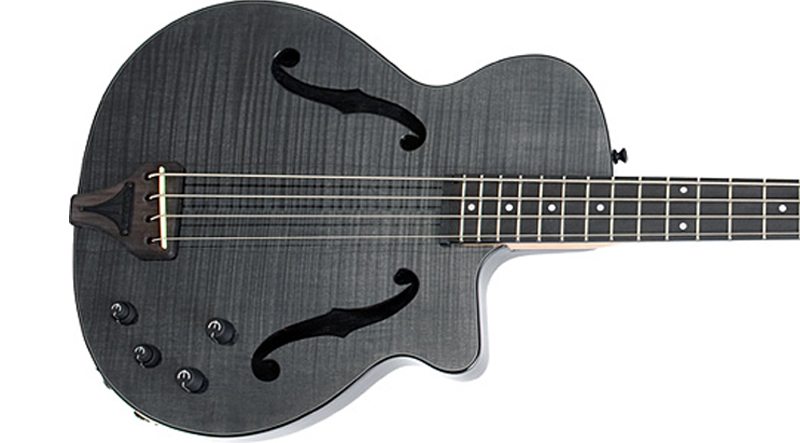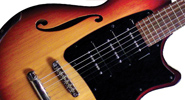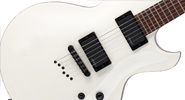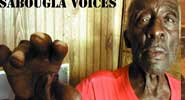
New Orleans Guitar Company Model 8
Price: $2,999
Contact: neworleansguitar.com
For over a decade, the New Orleans Guitar Company has been producing handcrafted electrics with an attention to design and detail possible only in a small shop. The vision of sculptor/luthier Vincent Guidroz was most eloquently conveyed in his Voodoo Custom and JB Custom guitars, with their figured tonewoods, neck-through construction, and fancy inlays.
But in the real world, less can lead to more. And when dealers and players started asking Guidroz for a high-quality New Orleans Guitar at a lower price, he devised the Model 8.
Made with the help of the modern luthier’s assistant – the CNC machine – the Model 8 has a four-bolt neck, six-on-a-side headstock, flat top, various pickup configurations, and a hardwood armrest. Holdover construction details include prime tonewoods for the top and back, a stainless-steel zero fret, multi-laminate neck, and an impressive polished finish.
Our Model 8 test guitar had a tobaccoburst, urethane finish that enhanced the grain of its one-piece ash top, bound in black. The three-piece korina back was untinted and the neck lightly shaded to amber, while the maker’s signature was visible under the finish at the back of the headstock. The circular lower bout has slightly offset waists and a graceful cutaway (with a barely perceptible point), attesting to the tasteful aesthetic of the guitarmaker.
Looks aside, the Model 8 design represents an opportunity to observe the fundamentals of guitar design. The body is hollow on the bass side, reducing weight and enhancing resonance, while the figured-maple neck is assembled from grain-aligned quartersawn stock, promoting stability and sustain. The headstock is tilted back 10 degrees, eliminating the need for string trees. The zero fret sits 3/8 of an inch from the expertly cut and beveled bone nut. The 22 German nickel-silver frets are medium jumbo sized and sit on a 251/2″-scale rosewood fingerboard with a 12″ radius.
Chrome Grover tuners, and matching Tone Pros tune-o-matic-style bridge and stop tailpiece are standard. DiMarzio pickups are mounted on the body with two screws through a black-plastic pickguard. Knurled chrome flat-top knobs, a three-way toggle, and an on/off mini switch for the middle pickup complete the visible hardware. Inside, a shielded control cavity houses carefully wired 250k CTS potentiometers with a 0.033-mF capacitor for the tone pot.
The layout of the black DiMarzio pickups has been thoughtfully considered; the middle is reverse-wound in reverse polarity to create a humbucking effect when added to the mix. The bridge pickup is mounted 17/8″ from the high-E saddle, allowing for plenty of bite but greater exposure to the singing part of the string. The bridge pickup is stock-wound, the middle is five percent under-wound and the neck pickup is 10 percent under-wound, creating a balanced output.
Strumming the Model 8 unplugged produced a gratifying ring, and plugging it into a late-’50s Ampeg Jet with a reissue Jensen speaker made a nice sonic platform.
Played clean, the neck P-90 is warm, yet articulate, and the bridge pickup rings with authority for blues and rock leads. But the secret weapon of this design is the middle pickup; kicking in the third P-90 unleashes the guitar’s inner twang. The frequency cancellation achieved with the middle pickup engaged in any combination brings out voices suitable for country chicken pickin’, funk rhythm, and rockabilly sizzle. Employing the full roar of an Ibanez TS-9 in-line, big chords pulsed with audible harmonics, and the taper of the Volume pot allowed for effective volume swells.
The New Orleans Guitar Company Model 8 offers a broad aural spectrum of satisfying, serviceable tones. Its weight and balance make it comfortable hanging on a strap, while the offset waist helps it rest well on a knee. The soft-shouldered D-profile neck is easy on the hand, and the setup makes for a pleasing playing experience. Designed for the working guitarist, it’s actually much more.
This article originally appeared in VG August 2012 issue. All copyrights are by the author and Vintage Guitar magazine. Unauthorized replication or use is strictly prohibited.
 As soon as this Louisiana native finished high school, he relocated to Denton, Texas, near Dallas, where he got a degree in Jazz Studies from the University of North Texas.
As soon as this Louisiana native finished high school, he relocated to Denton, Texas, near Dallas, where he got a degree in Jazz Studies from the University of North Texas.















 DLS Effects’ Reckless Drive is a two-channel overdrive/distortion effect with independent Volume, Gain, and Mix controls for each (Normal and Boost). It also has master controls for Bass and Treble, an Attack switch that adds brightness. It offers true-bypass switching with a 3P3T switch, Amphenol jacks, and its die-cast aluminum housing is finished with powdercoat and measures 3.7” x 4.7” x 1.7”. Go to www.dlseffects.com.
DLS Effects’ Reckless Drive is a two-channel overdrive/distortion effect with independent Volume, Gain, and Mix controls for each (Normal and Boost). It also has master controls for Bass and Treble, an Attack switch that adds brightness. It offers true-bypass switching with a 3P3T switch, Amphenol jacks, and its die-cast aluminum housing is finished with powdercoat and measures 3.7” x 4.7” x 1.7”. Go to www.dlseffects.com. TailPeace Dsignz guitar tailpieces replace a guitar’s standard stud-/bar-type tailpiece with sculpted pieces of varying design. They install with no modifcation to the instrument and do not contact the surface of the guitar. Made in the U.S., they are available in chrome, nickel, black, and gold finishes. Read more at www.TailPeace.com.
TailPeace Dsignz guitar tailpieces replace a guitar’s standard stud-/bar-type tailpiece with sculpted pieces of varying design. They install with no modifcation to the instrument and do not contact the surface of the guitar. Made in the U.S., they are available in chrome, nickel, black, and gold finishes. Read more at www.TailPeace.com. Seymour Duncan’s Vapor Trail is a true analog delay pedal that uses Bucket Brigade Devices (BBDs) the company says give it an authentic, vintage sound, but with a clarity that keeps it from getting lost in a mix. It has Rate and Depth controls, a TRS insert jack, and a translucent Delay knob with a blue LED that flashes to give visual feedback on delay time. It has a delay range of 15ms to 600ms, repeats can be set from one repeat to “runaway,” modulation-rate range of 0.2Hz to 4 Hz, and it is powered by 9-volt battery or a regulated power supply. For more, go to
Seymour Duncan’s Vapor Trail is a true analog delay pedal that uses Bucket Brigade Devices (BBDs) the company says give it an authentic, vintage sound, but with a clarity that keeps it from getting lost in a mix. It has Rate and Depth controls, a TRS insert jack, and a translucent Delay knob with a blue LED that flashes to give visual feedback on delay time. It has a delay range of 15ms to 600ms, repeats can be set from one repeat to “runaway,” modulation-rate range of 0.2Hz to 4 Hz, and it is powered by 9-volt battery or a regulated power supply. For more, go to